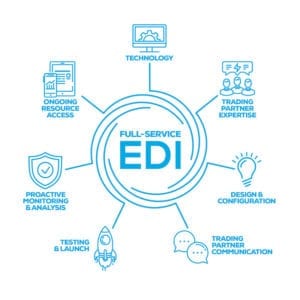Collaboration with trading partner networks raises all boats
Retailers who want to participate in a true omnichannel strategy and reap its rewards will find that it’s impossible to fully deliver on customers’ expectations without some amount of collaboration with trading partners. Likewise, vendors and suppliers that want to succeed in this era of increased competition must work harder to help their retail trading partners deliver on modern consumer expectations. The more closely trading partner networks can align, the more potential for lower costs and improved sales performance for everyone involved along the supply chain.
If you’re the 800 pound gorilla that is Walmart or Amazon, or even Nike and Coca-Cola, you can throw your weight around more with your trading partners and get them to comply with your policies and practices. For example, Walmart is getting stricter about enforcing “on time in full” requirements from their suppliers and getting those vendors in line for it to successfully compete with Amazon. When Nike reduced the number of retailers it works with to focus primarily on its 40 biggest retail partners in the U.S., those retailers reaped a bit of a windfall, but you can be assured that they’re all trying to follow this big brand’s requirements to the letter in order to ensure that number doesn’t fall to 39.
Chances are you don’t have the clout to be able to strong arm your trading partners into compliance. But you don’t really need it. Collaboration with a network itself — the actual cooperative sharing of information, responsibilities, ideas and promotional efforts — promises big enough business value for trading partners to engage.
Working closely with your trading partners can make many aspects of delivering on consumer expectations effortless. When more accurate, efficient, streamlined and automated your trading partner relationships are, the easier it is for the consumer to make a purchase and get the item they want. Delivering on those expectations can turn them into repeat customers, which leads to more sales and more profitability for all the links in the retail supply chain, and ultimately achieve profitable omnichannel execution. With the right systems in place, you and your trading partners can:
- Calculate more accurate forecasts
- Take advantage of on-time discounts
- Reduce overstocks, stock-outs and backorders
- Identify where all sources of inventory are located
- Make more strategic pricing and promotion decisions
- Streamline logistics and lower costs associated with shipping
- Communicate accurate product details across the ecosystem
- Identify trends more quickly, from regional level to store level
- Create more profitable assortment and product offering choices
- Practice tactical or lean inventory practices, such as Just In Time (JIT)
- Gain greater visibility into inventory throughout your network (and beyond)
- Execute more complex order fulfillment processes (buy online pickup in store (BOPIS or BOPUS), ship from store, etc.)
- And more.
Deliver on consumer expectations
When more collaboration is available across a trading partner network, more complex processes and strategic choices are possible to execute more efficiently and grow the business. Apply tools to calculate the closest and cheapest shipping options for e-commerce, including whether to ship from a distribution center or ship from a store that could be closer. Automatically order more product when existing stocks hit a predetermined level. Plan a more precise reverse logistics process for when customer returns do happen to reduce costs and get the inventory back to the best location for sale or liquidation.
Speaking of complex processes and strategic choices, many retailers and vendors seek to participate in drop shipping programs. Such relationships require close collaboration in order to set up all the systems needed to get the order from the retailer’s e-commerce website through to the vendor’s order fulfillment system and out for delivery. Once the item is on its way, it takes cooperation for the drop ship vendor to keep the retailer updated on the shipment, so the end-customer can track the package through transit.
Ensuring inventory, product availability
With more data shared across trading partner networks, it opens up the opportunity to drive more sales which makes both retailers and suppliers happy. With analytic applications, retailers can provide suppliers with visibility into how their items sell-thru at the store level along with consumer feedback, so they can make adjustments to product offerings. On the flip side of the coin, suppliers and vendors have insights into how their products perform with all of their retailers and may be able to offer assortment advice.
Smaller retailers can also benefit from giving their larger suppliers a look at their own point of sale (POS) data, because it can lead to greater understanding of how to better market and promote those products. More effective promotional execution means more sales for the retailer, which also benefits the supplier. And if there’s a 3PL or freight carrier involved in the process, they can benefit from closer, more consistent relationships among their trading partner networks as well.
Shipping and carrier rates
With more trusting relationships, trading partners may be willing to negotiate on shipping and carrier rates. More precise inventory management and potential changes in purchase quantities could mean changes to LTL (Less Than Truckload) and TL (Truck Load), which could in turn impact shipping charges and carrier rates. A drop ship vendor may offer special shipping rates to retailers that meet a certain threshold of orders or order values. Changes in relationships with 3PLs may lead to adjustments as well.
Collaboration’s value among a trading partner network has the potential for accelerating returns. Imagine the spirit of collaboration explored here and multiply it across every trading partner in a network. What would a 10% improvement look like for each partnership, whether it’s on-time deliveries, better communication, reduction in order errors or improved total sales? What would it mean if more accurate, more granular and detailed data was exchanged between you and everyone in your supply chain?
How much higher can your business reach when all of the links and cogs surrounding it are running as efficiently and accurately as possible, working together to ensure product availability, appropriate variety and consumer experience satisfaction?
Working together in a collaborative manner by sharing POS and inventory data as well as leveraging the automation power of Electronic Data Interchange (EDI) solutions can benefit everyone in the supply chain. To learn more about trading partner networks and how to utilize them, please ask to speak with one of our omnichannel specialists.

Find the correct EDI solution for your business.
Get more insights on full-service EDI by downloading our white paper.
READ OUR WHITE PAPER- 6 Tips for Better Collaboration with Trading Partners - May 9, 2017

GET MONTHLY UPDATES DELIVERED TO YOUR INBOX.
Never miss an update from the SPS blog! Receive retail and supply chain news, valuable resources, expert tips and more.

RELATED POSTS
4 strategies to conquer lean inventor...
Best Practices to Drive Sell-Through
How to Proactively Mitigate At-Risk O...